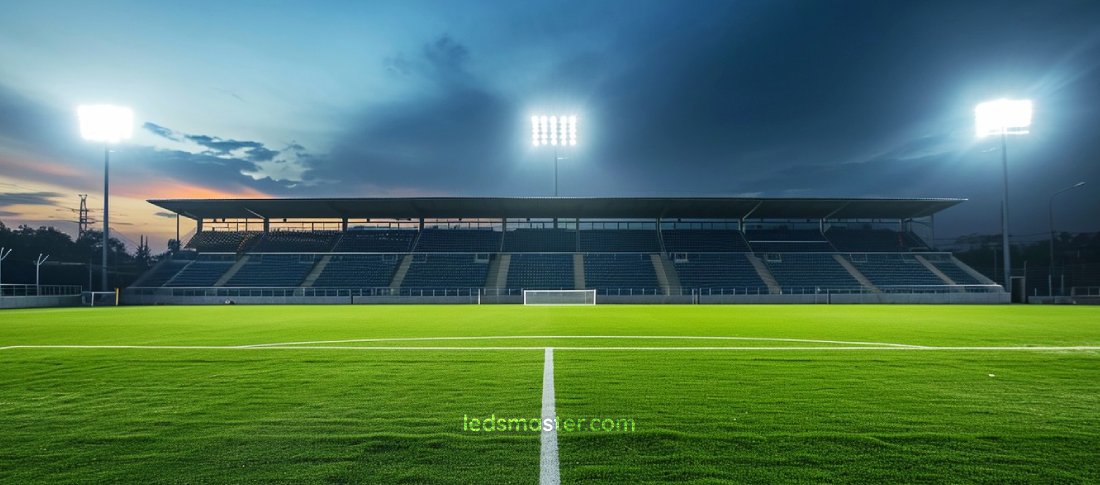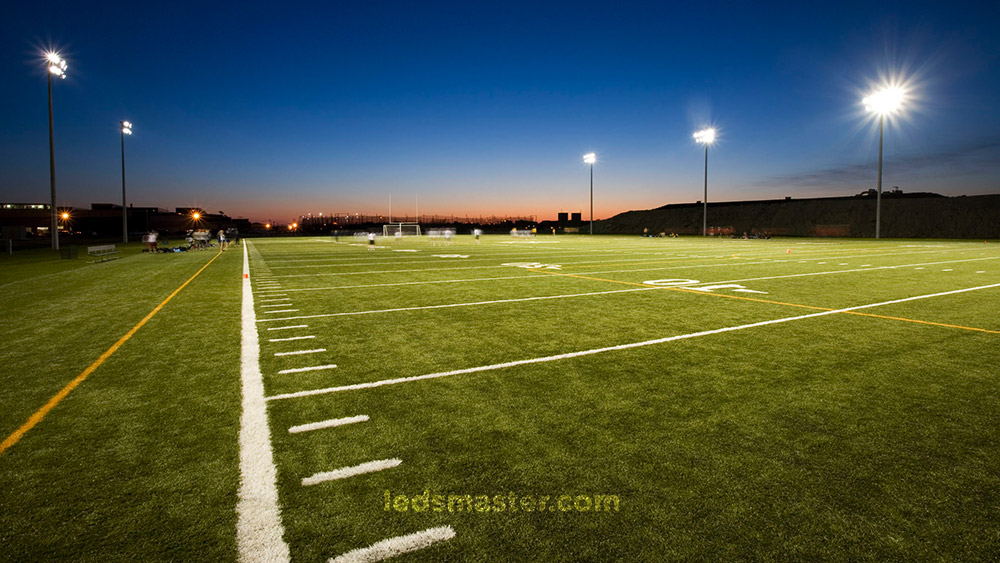In recent years, the lighting of football fields has become increasingly crucial as the popularity of nighttime play continues to rise. With more people engaging in football after dark, the quality and effectiveness of field illumination have gained significant attention. A key aspect influencing the lighting quality, such as the uniformity and brightness of the football field, is the height of the floodlights.
The height of poles for football field lights does not have a one-size-fits-all answer. This variability is due to a range of factors including the level of competition, the size of the field, and specific design considerations. Generally, the height of football field light poles spans a broad range, typically from 12 to 60 meters (40 to 200 feet). For fields intended for recreational use, shorter poles are often sufficient to provide adequate lighting. In contrast, fields used for professional and international tournaments, like those overseen by FIFA or the Premier League, typically feature taller poles to meet stringent lighting standards and ensure optimal visibility for players and spectators alike.
Understanding these variations in pole height is essential for ensuring that football fields are properly lit for their intended use, thereby enhancing the overall playing experience and safety for participants.
Table of Contents
ToggleHow Tall are Football Field Lights?
| Type of football field | How tall is football field lighting |
| Recreational or training | 12 to 18 meters (40 to 60 feet) |
| High school football field | 15 to 25 meters (50 to 82 feet) |
| Football stadium for FIFA, Premier League, Olympic Games, etc | 30 to 60 meters (100 to 200 ft) |
The height of masts for football field lighting can vary significantly based on the intended use of the field and the level of competition it supports. For recreational or community football fields, light masts typically range between 12 and 18 meters (approximately 40 to 60 feet) in height. This height is generally adequate to provide sufficient lighting for local matches, practices, and community events, ensuring a well-lit playing area without the need for extremely high masts.

In contrast, football stadiums or fields that host higher-level competitions, such as professional or international matches, require more substantial lighting solutions. For these venues, masts are often significantly taller, commonly exceeding 30 meters (100 feet). This increased height is necessary to accommodate the stringent lighting requirements that ensure uniform illumination, adequate brightness, and minimized shadows across the playing field. Such standards are crucial for facilitating high-quality gameplay, enhancing the viewing experience for spectators, and meeting broadcasting needs.
The specific height of the lighting masts is determined by various factors including the size of the field, the level of competitive play, the presence of seating or other structures that may obstruct light, and the desired quality of illumination. Taller masts allow for a more even distribution of light and reduce the need for additional lighting fixtures, which can help in creating a visually appealing and functional lighting environment.
In addition to height, the type of lighting technology used plays a significant role in achieving optimal lighting conditions. Modern solutions often involve advanced technologies like LED lights, which offer greater efficiency, longer lifespan, and better control over light distribution compared to traditional lighting systems.
When planning the lighting for a football field, it is essential to consider these factors comprehensively to ensure that the lighting design meets the specific needs of the venue. Properly designed lighting not only improves the overall experience for players and spectators but also contributes to the safety and usability of the field.
For those looking for tailored advice and a professional lighting design, we offer expert consultation services. Our team can provide a free lighting design that takes into account your field’s unique requirements, ensuring optimal lighting performance. Don’t hesitate to contact us for more information and to explore how we can assist in enhancing your football field’s lighting setup.

The Significance of Tall Poles in Football Field Lighting Design
Uniform Illumination
The primary function of tall light poles is to provide uniform illumination across the football field. Tall poles help to distribute light more evenly by minimizing the intensity of shadows and ensuring that the entire playing area is adequately lit. When light fixtures are positioned at higher elevations, they cover a larger area and create a more uniform light spread, reducing the likelihood of dark spots and glare that can impede visibility. This uniform lighting is essential for players to see the ball and each other clearly, which is particularly crucial during fast-paced play.
Enhanced Visibility
Tall light poles enhance visibility by projecting light from a higher vantage point, thus reducing the angle of incidence. This means that the light hits the field at a more downward angle, which helps to illuminate players and objects more clearly. This improved visibility is vital not just for the players but also for referees, coaches, and spectators. High-quality lighting ensures that the game can be played safely and fairly, and it also enhances the viewing experience for fans, both in the stadium and those watching broadcasts.
Reduced Glare
Glare can be a significant issue in sports lighting, where improperly positioned or low-height lights can shine directly into players’ eyes, affecting their performance. Tall light poles mitigate this problem by allowing light to be directed more accurately onto the field without directly shining into the eyes of players or spectators. This reduction in glare not only improves gameplay but also reduces the risk of accidents and injuries that can occur when players are temporarily blinded or distracted by bright lights.
Accommodating Different Field Uses
Football fields serve a variety of purposes, from local community games to international tournaments. The height of the light poles can be adjusted to meet the specific needs of these different uses. For recreational fields, where the lighting demands are lower, shorter poles around 12 to 18 meters (40 to 60 feet) may suffice. However, for professional stadiums and international competitions, taller poles exceeding 30 meters (100 feet) are often required to meet stringent lighting standards. These taller poles ensure that the field is brightly and uniformly lit, which is crucial for high-level competition and for meeting the requirements of broadcasting and media coverage.
Optimizing Light Placement
Tall light poles allow for more flexible and effective placement of light fixtures. When lights are mounted at a greater height, it is easier to position them in a way that avoids obstructions such as grandstands or other structures. This flexibility in placement ensures that the light reaches all corners of the field, providing comprehensive coverage and minimizing dark areas. It also helps in directing the light precisely where it is needed, enhancing the efficiency of the lighting system.
Supporting Advanced Lighting Technologies
Modern football field lighting systems often incorporate advanced technologies such as LED lights. These technologies offer numerous benefits, including better energy efficiency, longer lifespan, and more precise control over light distribution. Tall poles are particularly advantageous for these advanced systems, as they allow for the installation of sophisticated lighting fixtures that can be angled and positioned to maximize their effectiveness. This can result in significant improvements in light quality and energy savings over traditional lighting solutions.
Aesthetic and Environmental Considerations
In addition to their functional benefits, tall light poles can also contribute to the aesthetic appeal of a football field. When designed thoughtfully, they can blend into the architecture of the stadium or sports complex, adding to its overall visual appeal. Furthermore, taller poles can be designed to minimize light pollution, directing light downward onto the field and reducing spillage into surrounding areas. This is particularly important in urban environments where light pollution can be a concern for nearby residents.
Conclusion
The height of football field light poles is crucial for achieving effective illumination, especially for nighttime play. Tall poles ensure uniform light distribution, enhance visibility, and reduce glare, which are essential for player safety. While recreational fields can use shorter poles, professional stadiums require taller ones to meet higher lighting standards. Advances in lighting technology, such as LED systems, are better supported by taller poles, making them integral to modern field lighting design.

